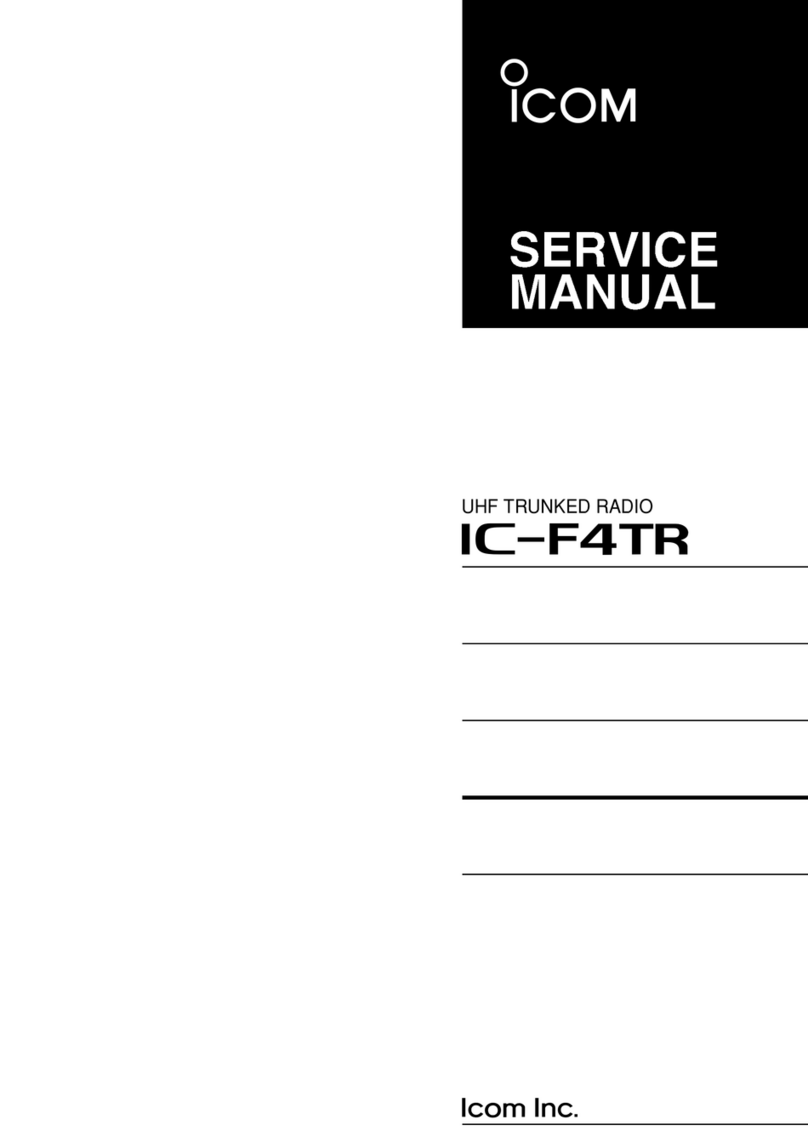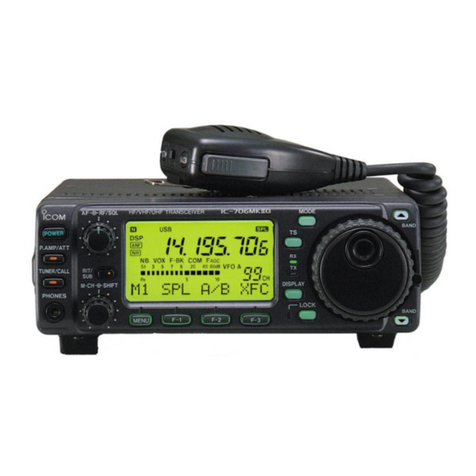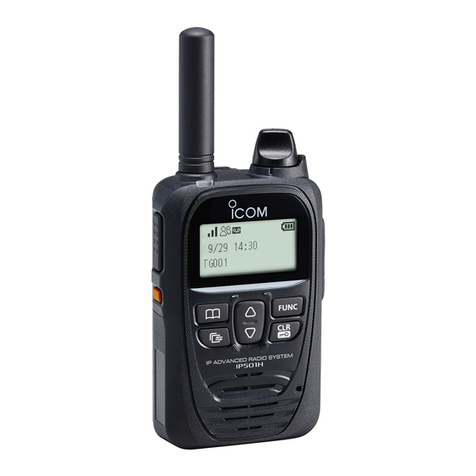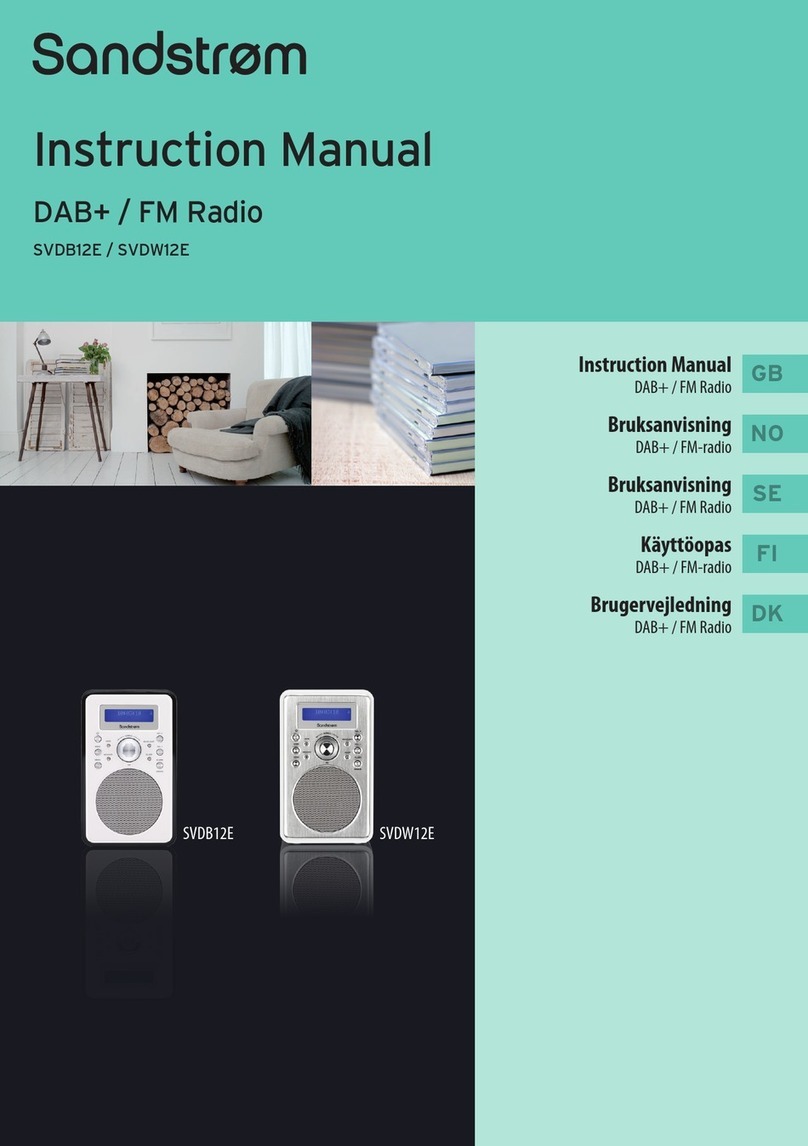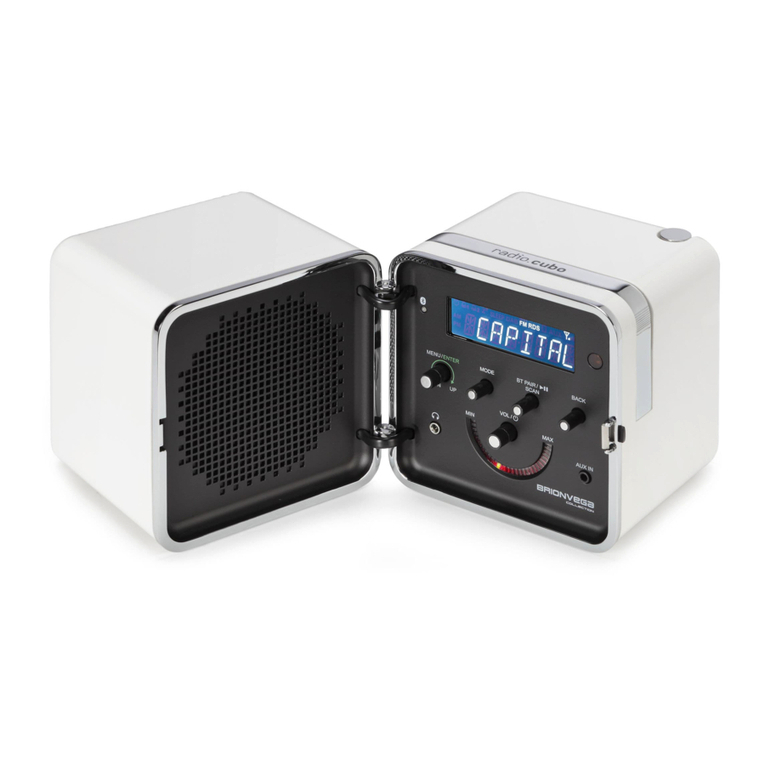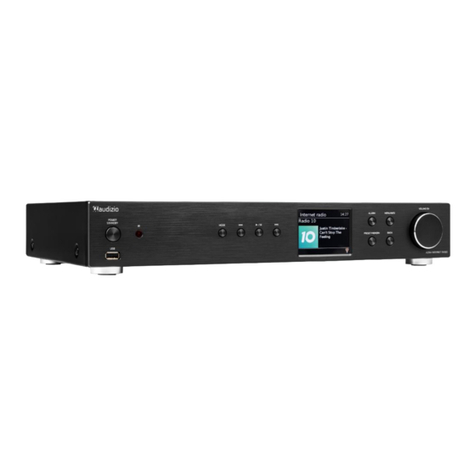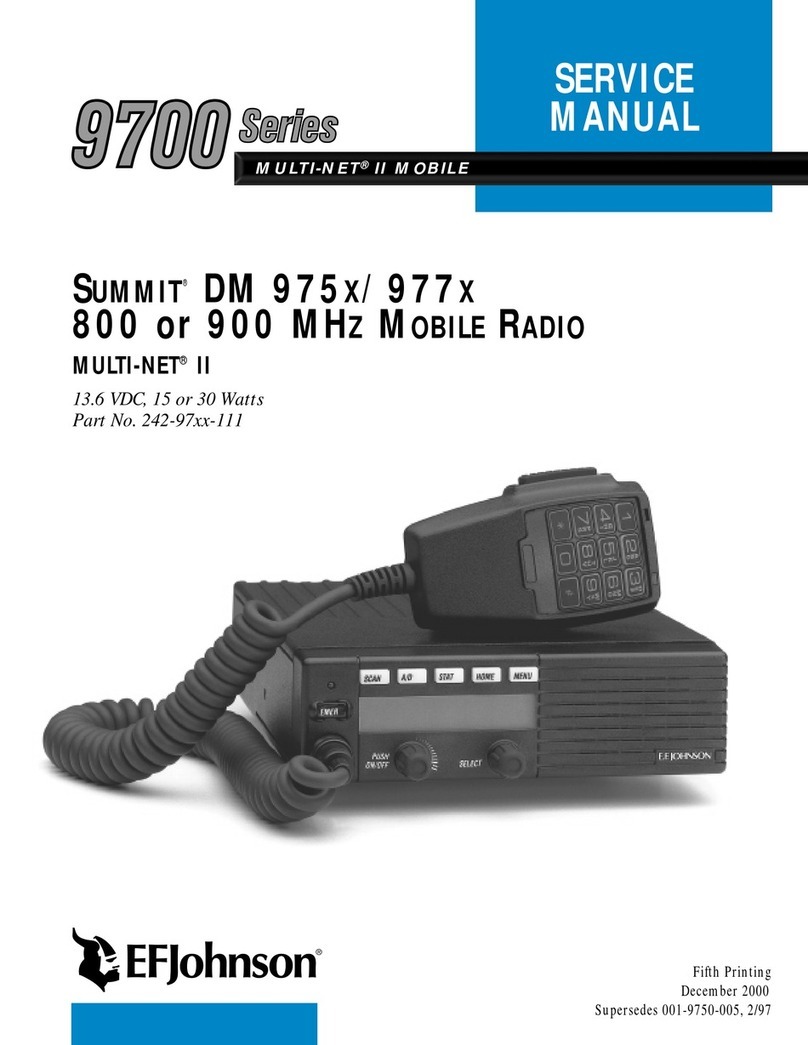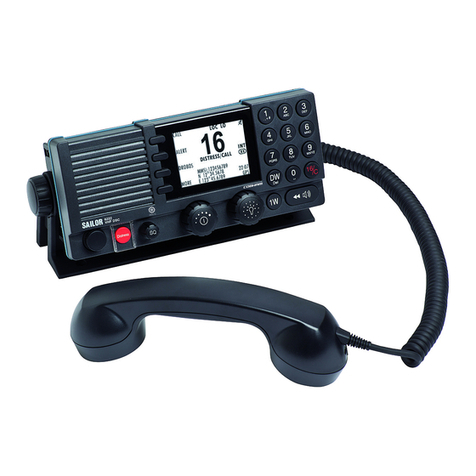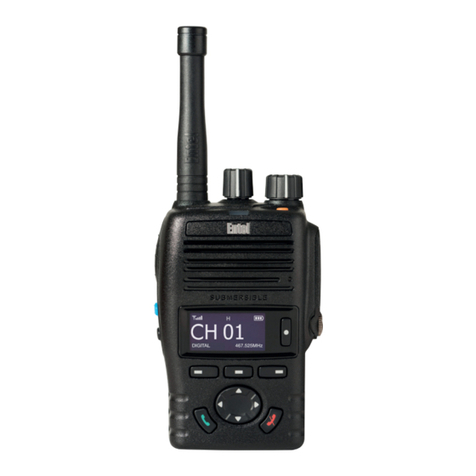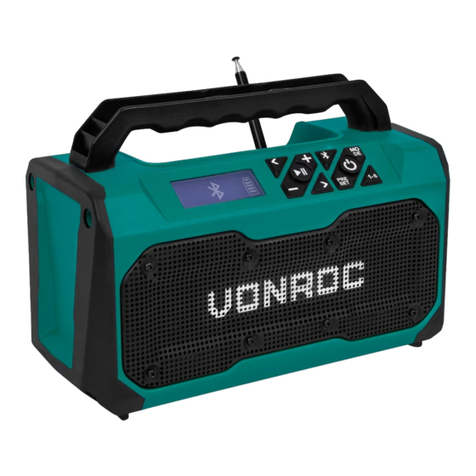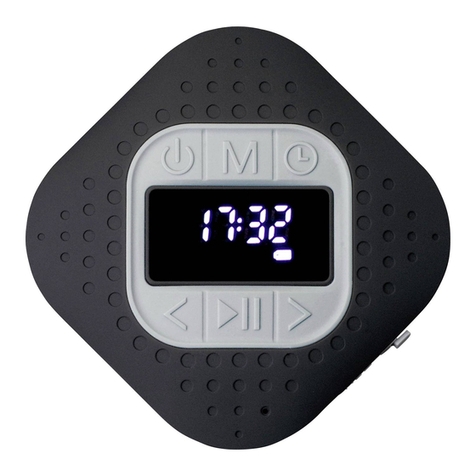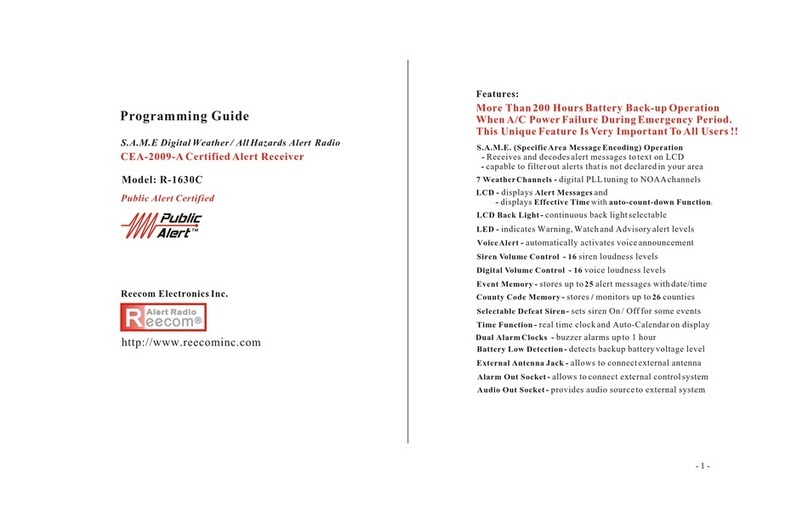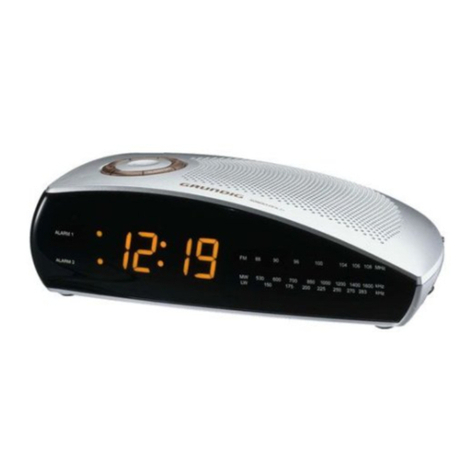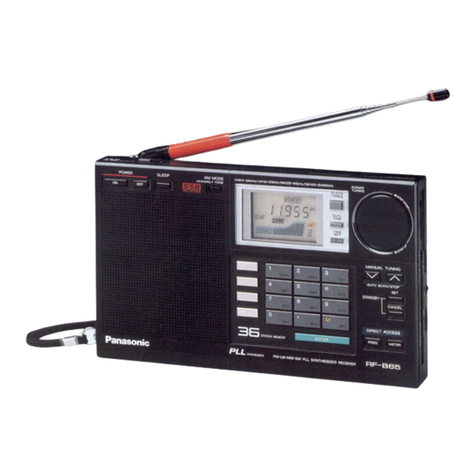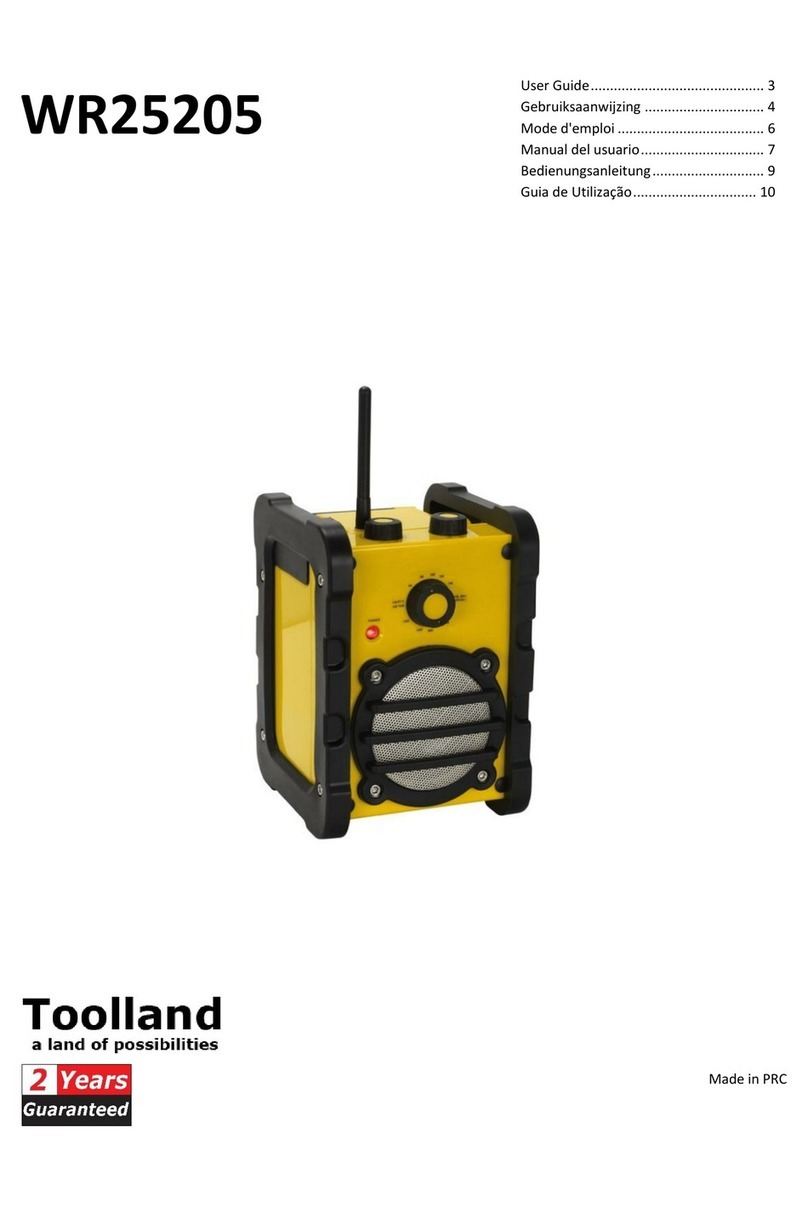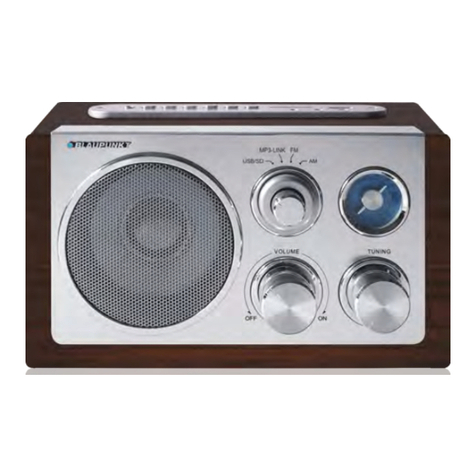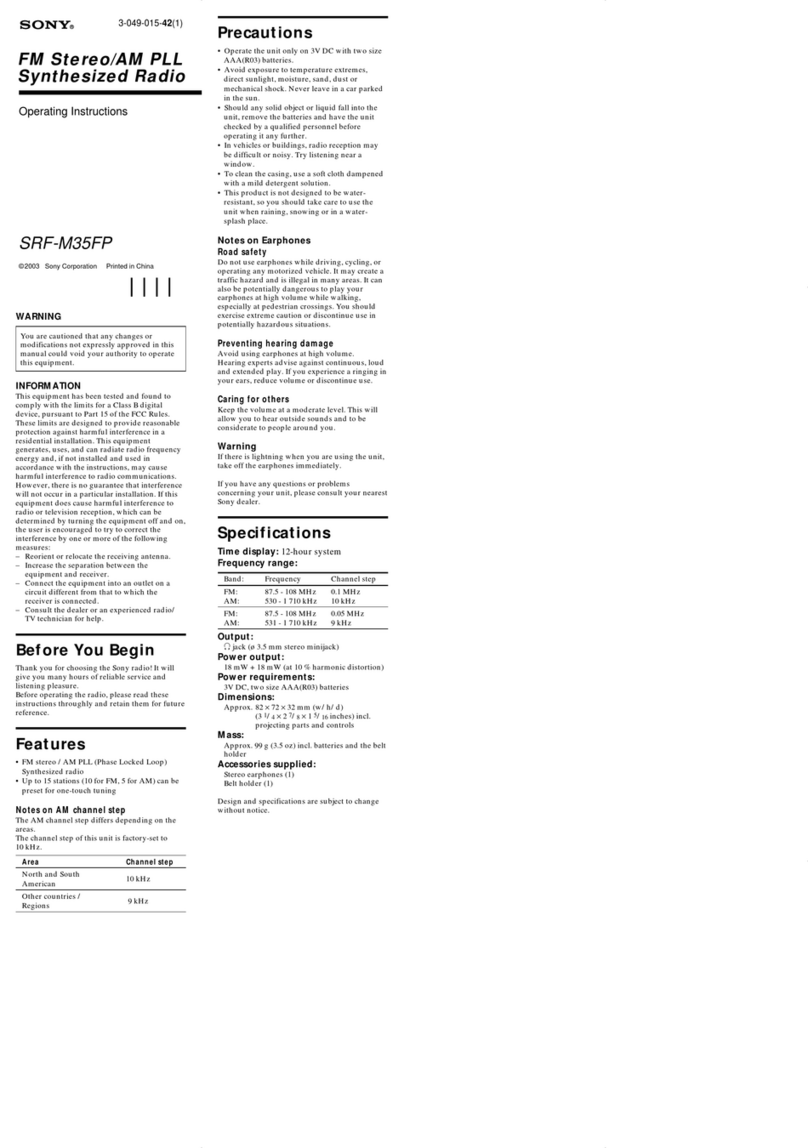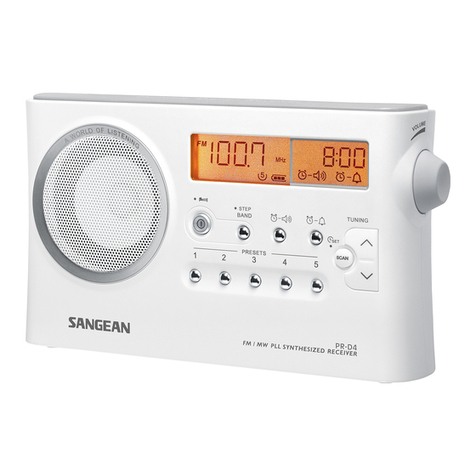Icom IC-SAT100M Installation guide


1
Thank you for choosing this Icom product.
This product is designed and built with Icom’ s state of the art technology and craftsmanship.
With proper care, this product should provide you with years of trouble-free operation.
Important
READ ALL INSTRUCTIONS carefully and completely before using the transceiver.
SAVE THIS INSTRUCTION MANUAL — This instruction manual contains important
operating instructions for the IC-SAT100M.
For Advanced features and instructions, see the OPERATING MANUAL on the Icom
website for details.
https://www.icomjapan.com/support/
Explicit definitions
WORD DEFINITION
WARNING!
CAUTION Equipment damage may occur.
NOTE
electric shock.
Features
Real-Time Communication with the Iridium® LEO (Low Earth Orbit) satellite network,
covering all over the globe including the Poles
One-to-many communication (Maximum 15 Groups)
1500 mW powerful audio
Multiple language (Chinese, English, French, Japanese, and Spanish)
ENGLISH
Icom is not responsible for the destruction, damage to, or performance of any Icom or
non-Icom equipment, if the malfunction is because of:
•
other natural disasters, disturbances, riots, war, or radioactive contamination.
• The use of Icom transceivers with any equipment that is not manufactured or approved by
Icom.

2
For the transceiver
WARNING! NEVER operate the
transceiver during a lightning storm. It may
damage the transceiver. Always disconnect
the power source and antenna before a
storm.
WARNING! NEVER place the
transceiver where normal operation of the
vehicle may be hindered or where it could
cause bodily injury.
WARNING! Immediately disconnect
the AC adapter if the transceiver emits an
abnormal odor, sound or smoke. Contact
your Icom dealer or distributor for advice.
CAUTION: NEVER connect the transceiver
to a power source of more than 33 V DC.
This could damage the transceiver.
CAUTION: NEVER cut the DC power cable
between the DC plug and fuse holder. If an
incorrect connection is made after cutting,
the transceiver might be damaged.
CAUTION:
jacks are dry and clean before attachment.
Exposing them to dust or water will result in
serious damage to the transceiver.
CAUTION: The Antenna unit will become
hot when operating continuously for long
periods.
DO NOT place or leave the transceiver
in areas with temperatures below –30°C
(–22°F) or above +60°C (+140°F), or in
areas subject to direct sunlight, such as the
dashboard.
DO NOT operate the transceiver without
running the vehicle’s engine. The vehicle’s
battery will quickly run out when the
transceiver transmits while the vehicle’s
engine is OFF.
DO NOT place or leave the transceiver in
excessively dusty environments.
DO NOT
place the transceiver against walls.
Otherwise heat dissipation will be obstructed.
DO NOT use harsh solvents such as
damage the transceiver’s surfaces.
Keep the transceiver away from the heavy
rain, and never immerse it in the water.
The transceiver meets IP54(main unit)* /
IP55 (microphone) / IP67 (antenna unit)
requirements for dust-protection and splash
resistance. However, once the transceiver
has been dropped, dust protection and
splash resistance cannot be guaranteed
due to the fact that the transceiver may be
cracked, or the waterproof seal damaged,
and so on.
*Only when the microphone is attached.
Other microphones have different pin
assignments and may damage the
transceiver.
Place the transceiver in a secure place
persons.
In some countries, using a satellite
communication device may be prohibited,
or a license is required. Make sure you
comply with all applicable laws and
regulations in your area.
Precautions

3
For the optional AC adapter
WARNING! NEVER use other than the
transceiver. This may result in an electrical
adapter.
WARNING! Connect the adapter into
an outlet between 100 V and 240 V AC.
Otherwise, this may result in an electrical
adapter.
WARNING! NEVER install the AC
adapter to wet place where is outside or
AC adapter.
WARNING! NEVER put something
heavy on the AC adapter cable. This may
damage the AC adapter.
WARNING! NEVER modify, bend by
force, twist, pull or heat the AC adapter’s
cable. This may result in an electrical shock,
WARNING! NEVER
touch the AC adapter
with wet hands. This may result in an
electrical shock or damage the AC adapter.
WARNING! NEVER
use the AC adapter
when it can not closely insert into the AC
outlet. This may result in an electrical shock,
WARNING! Use and place the AC
adapter and connection cable to avoid
inadvertent use by children. This may result
in an electrical shock or cause injury.
About the GPS receiver
• Do not cover the antenna with anything that
will block the satellite signals.
• GPS signals cannot pass through metal
objects. When using the transceiver inside
a vehicle, you may not receive GPS signals.
We recommend you use it near a window.
• The GPS receiver may not work if used in
the following locations:
1. Tunnels or high-rise buildings
2. Underground parking lots
3. Under a bridge or viaduct
4. In remote forested areas
5. Under bad weather conditions
(rainy or cloudy day)
• The Global Positioning System (GPS) is built
and operated by the U.S. Department of
defense. The Department is responsible for
accuracy and maintenance of the system.
Any changes by the Department may affect
the accuracy and function of the GPS
system.
Certification
([OK] > Information > )
Certification
Icom, Icom Inc. and Icom logo are registered
trademarks of Icom Incorporated
(Japan) in Japan, the United States, the United
Kingdom, Germany, France, Spain, Russia,
Australia, New Zealand, and/or other countries.
The Bluetooth® word mark and logos are registered
trademarks owned by Bluetooth SIG, Inc. and any
use of such marks by Icom Inc. is under license.
Other trademarks and trade names are those of their
respective owners.
3M, PELTOR, and WS are trademarks of 3M
Company. All other products or brands are registered
trademarks or trademarks of their respective holders.
Iridium, and the Iridium logo are registered

4
About CE and DOC
Hereby, Icom Inc. declares
that the versions of IC-
SAT100M which have
product, comply with
the essential requirements of the Radio
Equipment Directive, 2014/53/EU, and the
substances in electrical and electronic
equipment Directive, 2011/65/EU. The full
text of the EU declaration of conformity is
available at the following internet address:
https://www.icomjapan.com/support/
Disposal
The crossed-out wheeled-
bin symbol on your product,
literature, or packaging reminds
you that in the European Union,
all electrical and electronic
products, batteries, and
accumulators (rechargeable batteries)
must be taken to designated collection
locations at the end of their working life.
Do not dispose of these products as
unsorted municipal waste. Dispose of them
according to the laws in your area.
About E-marking: Detailed installation notes for
are available. Please contact your Icom dealer or
distributor.
FCC information
This device complies with part 15 of the
FCC Rules. Operation is subject to the
condition that this device does not cause
harmful interference.
This equipment has been tested and found
to comply with the limits for a Class B
digital device, pursuant to part 15 of the
FCC Rules.
These limits are designed to provide
reasonable protection against harmful
interference in a residential installation.
This equipment generates, uses and
can radiate radio frequency energy and,
if not installed and used in accordance
with the instructions, may cause harmful
interference to radio communications.
However, there is no guarantee that
interference will not occur in a particular
installation. If this equipment does cause
harmful interference to radio or television
reception, which can be determined by
turning the equipment off and on, the
user is encouraged to try to correct the
interference by one or more of the following
measures:
• Reorient or relocate the receiving antenna.
• Increase the separation between the
equipment and receiver.
• Connect the equipment into an outlet on
a circuit different from that to which the
receiver is connected.
• Consult the dealer or an experienced radio/
TV technician for help.
CAUTION: Changes or modifications to
this transceiver, not expressly approved
by Icom Inc., could void your authority
to operate this transceiver under FCC
regulations.

5
Safety training information
Your Icom radio generates
RF electromagnetic energy
during transmit mode. This
radio is designed for and
Use Only”, meaning it must be used
only during the course of employment
by individuals aware of the hazards, and
the ways to minimize such hazards. This
radio is NOT intended for use by the
environment.
• For compliance with FCC and IC RF
Exposure Requirements, the transmitter
antenna installation shall comply with the
following three conditions:
1. The transmitter antenna gain shall not
exceed 3 dBi.
2. The antenna is required to be located
outside of a vehicle and kept at a
distance of 20 centimeters (7.9 inches)
or more between the transmitting
antenna of this device and any persons
during operation. For small vehicle
as worst case, the antenna shall be
located on the roof top at any place
on the center line along the vehicle in
order to achieve 20 centimeters (7.9
inches) separation distance. In order
to ensure this distance is met, the
installation of the antenna must be
mounted at least 20 centimeters (7.9
inches) away from the nearest edge of
the vehicle in order to protect against
exposure to bystanders.
3. Transmit only when people
outside the vehicle are at least the
recommended minimum distance
of 20 centimeters (7.9 inches) away
from the properly installed antenna.
This separation distance will ensure
that there is sufficient distance from a
properly installed externally-mounted
antenna to satisfy the RF exposure
requirements in the applicable RF
exposure compliance standards.
To ensure that your
exposure to RF
electromagnetic energy
is within the FCC and
IC allowable limits for
occupational use, always adhere to the
following guidelines:
•DO NOT operat e the radio without a proper
antenna attached, as this may damage the
radio and may also cause you to exceed
FCC and IC RF exposure limits. A proper
antenna is the antenna supplied with this
radio by the manufacturer or an antenna
for use with this radio.
•DO NOT transmit for more than 50% of
Transmitting more than 50% of the time can
cause FCC and IC RF exposure compliance
requirements to be exceeded. The radio is
transmitting when the status indicator lights
red. You can cause the radio to transmit by
Electromagnetic Interference/Compatibility
During transmissions, your Icom radio
generates RF energy that can possibly
cause interference with other devices
or systems. To avoid such interference,
turn off the radio in areas where signs
are posted to do so. DO NOT operate
the transmitter in areas that are sensitive
to electromagnetic radiation such as
hospitals, aircraft, and blasting sites.

6
Table of contents
Important ...............................................................................................................1
..................................................................................................1
Features ................................................................................................................1
Precautions ...........................................................................................................2
About the GPS receiver ........................................................................................3
...........................................................................................................3
About CE and DOC ...............................................................................................4
Disposal ................................................................................................................4
FCC information ....................................................................................................4
Safety training information ....................................................................................5
Table of contents ...................................................................................................6
1 PANEL DESCRIPTION ...............................................................................................7
Microphone Description ........................................................................................7
Function display ....................................................................................................8
2 BASIC OPERATION ...................................................................................................9
Receiving and transmitting ....................................................................................9
3 MENU SCREEN ........................................................................................................10
Construction ..........................................................................................................10
4 CONNECTING AND MAINTENANCE ...................................................................... 11
Rear panel connection ..........................................................................................11
Antenna unit ..........................................................................................................12
Cleaning ................................................................................................................12
Supplied accessories ............................................................................................12
Fuse replacement .................................................................................................12
5 OPTIONS AND TECHNICAL INFORMATION ..........................................................13
Options ..................................................................................................................13
Technical Information ............................................................................................13

7
1PANEL DESCRIPTION
Microphone Description
EMERGENCY KEY [EMER]
Hold down to transmit an Emergency
call.
SIDE 1 KEY [S1]
Push to display the Message List.
PTT SWITCH [PTT]
Hold down to transmit, release to
receive.
P1/P2 KEYS [P1]/[P2]
Push to use the function assigned in the
([OK] > Functions > Key Setup)
SIDE 2 KEY [S2]
Hold down to turn ON or OFF the RX
Speaker function.
SIDE 3 KEY [S3]
Push to display the Public Address.
MENU/OK KEY [OK]
Push to enter the Menu screen.
Push to select an item in the Menu
screen.
BACK/HOME KEY [BACK]
Push to return to the previous Menu
screen.
Hold down to exit the Menu screen.
DIRECTIONAL KEY [UP]/[DOWN]/
[LEFT]/[RIGHT]
Push to select a menu item, setting,
and so on.
STATUS INDICATOR
Lights green while receiving.
status.
Lights red while transmitting.
Blinks orange while registering, or no
satellites found.
VOLUME/POWER CONTROL [VOL]
Hold down to turn the transceiver ON
or OFF.
Rotate to adjust the audio output
level.
TALKGROUP SELECTOR
Rotate to select a talkgroup.
Connecting
Connect the supplied microphone as illustrated below.
Microphone
Speaker

8
PANEL DESCRIPTION 1
Function display
Icon Area
Indicators
SIGNAL STRENGTH
Displays the relative receive signal strength
level.
NOTE:
The antenna indicator “
if the connection with a satellite is not
established. Keep the antenna vertical and wait
until you are connected, or move your position
to the place with a clear view of the sky.
CLOCK
Displays the current time.
Icons
The following icons are displayed in the
Icon Area.
LOCK
Displayed when the Lock function is ON.
SURVEILLANCE
Displayed when the Surveillance function
is ON.
Bluetooth®
• “
• “
connected.
MESSAGE
• Displayed when a message has been
received.
• Displayed if unread messages are still in the
Message memory.
RECORD
Displayed when the Record function is ON.
SCAN
• Displayed when a scan is paused.
• Blinks while scanning.
RX Speaker
Displayed when the RX Speaker function is
activated.
Text Area
Displays the status, preset transceiver
name, and selected Talkgroup Name.
Status Description
IDLE The selected Talkgroup is
not active.
OPEN
The selected talkgroup is
active but no one is talking.
REQUESTING Requesting the
transmission.
TALKING Transmitting
LISTENING Receiving
SCANNING Scanning a call
BUSY
Cannot transmit because
the audio is being received.
Key Display Area
Displays the names of the function
assigned to [P1] and [P2].
The display is shown in English as an example. Select other languages on the Menu
screen, if necessary. ([OK] > Display > Language)
Last call Scan
00:00 Icon area
Text area
Key display area

9
2BASIC OPERATION
Receiving and transmitting
Turning ON the transceiver
Hold down [VOL] for 1 second to turn
ON the transceiver.
• The transceiver searches a satellite.
• When the transceiver connected and
registered to the satellite, the status
name is displayed.
Push [Last Call] to playback the
received call.
(See the IC-SAT100M OPERATING
MANUAL for Last Call Play function
details.)
Push [UP] or [DOWN] to display the
Talkgroup List.
Rotate Talkgroup selector to select a
talkgroup.
Receiving
source transceiver’s name are displayed,
and audio should be heard.
Rotate [VOL] to adjust the audio output level.
Last Call Ignore
LISTENING
TRANSCEIVER2
TALKGROUP01
Transmitting
CAUTION: DO NOT transmit without an
antenna.
1. Hold down [PTT].
transceiver requests the transmission.
2.
at your normal voice level.
You can continuously transmit up to the
period of time allowed by the system.
Last Call Scan
TALKING
TRANSCEIVER1
TALKGROUP01
NOTE:
• If the connection becomes poor while
transmitting, the transceiver sounds the
• You cannot transmit while listening to
the received audio. Before transmitting,
Scan and Ignore
[Scan]
Push to scan a call.
[Ignore]
Push to ignore the received call.
The Ignore function will be canceled if there
are no more calls for 90 seconds or more.
NOTE: The transceiver receives and
transmits using several satellites orbiting
the same orbit. Receiving and transmitting
may fail depending on the satellite position
or any obstacles between the transceiver
and satellites.
Receiving and transmitting may fail,
depending on the satellite positions or
nearby obstacles.
8°

10
3
MENU SCREEN
You can use the Menu screen to set
infrequently changed values or function
settings.
Construction
The Menu screen is constructed in a tree
structure.
You can go to the next tree level with
[RIGHT] or [OK], go back a level with
[LEFT] or [BACK].
To select an item, push [UP] or [DOWN].
See the OPERATING MANUAL for each
menu item’s details. You can download
the OPERATING MANUAL from the Icom
website.
The menu items contained in the
transceiver may be different, depending
on the transceiver’s version or presettings.
Ask your dealer for details.
https://www.icomjapan.com/support/
Talkgroup
Refresh Talkgroup
Talkgroup List
PTT Option
Talk Timer
Mic Gain
Call Recorder
Received Message
Message List
Location Sharing
Position Format
Distance Format
Bluetooth
Bluetooth ON/OFF
BT Device List
Bluetooth Reset
BT Auto Connect
BT Audio Setting
BT Device Info
Key Beep (VS-3)
PWR Save (VS-3)
PTT Beep (VS-3)
One-touch PTT
Waiting Pairing
Functions
Auto Keypad Lock
Key Setup
P1 Key
P2 Key
PC Command
Auto TX Mic Sel
Clock
Clock Display
Time Format
Clock Time Zone
DST
Display
Backlight
Contrast
Language
Beep
System Beep Lv
Emer Beep Lv
Key Beep Lv
Ringer Lv
Opening Beep Lv
Information
Battery Info
RSSI
My Position
Firmware Info
Satellite Info
Certification

11
4CONNECTING AND MAINTENANCE
Rear panel connection
EXTERNAL SPEAKER JACK
IGNITION LEAD
Connect to an ignition line.
CAUTION: DO NOT put pressure on
this lead. Binding to the DC power
cable is recommended.
DC POWER CONNECTOR
Connect to a 12 V/24 V DC battery.
Pay attention to polarities. Red line: ,
Black line:
You can also connect the optional AC adapter.
CAUTION: DO NOT
reverse the DC power
cable polarity when connecting to a power
source. This could damage the transceiver.
LAN CABLE
(Gray: for antenna, Black: for IP Network)
Connect the supplied antenna or
network devices such as a HUB.
CAUTION: DO NOT
connect other than
network devices, such as microphone.
This could damage the transceiver.
Change the static IP address when the
transceiver is connected to network devices.
Before using the transceiver, setting a
static IP address to the antenna unit and
the main unit.
Default: Main Unit : 192.168.0.1,
Antenna Unit : 192.168.0.2
D-Sub 25-pin
Connect to use the function extension.
Ask your dealer for details.
Optional
speaker
Installing the outdoor antennas
Keep a minimum
of 20 cm (7.9
inch) between the
Antenna unit and
your body.
Move away
from buildings
and use the
transceiver in
areas with an
open sky.
Install the outdoor antennas in a place with a
clear view of the sky. Make sure that there are no
obstacles, such as buildings or trees, at higher
than about 8 degrees around the antenna.
20 cm
7.9 inch
8°
WARNING! NEVER
remove the fuse
holders from the DC
power cable.
Red : ,
Black : Fuse holders
12 V or 24 V
Battery
NOTE: Use the terminals as shown
below for the cable connections.
Crimp Solder

12
CONNECTING AND MAINTENANCE 4
Antenna unit
A key element in the performance of any
communication systems is the antenna.
Contact your dealer for information
regarding antennas and how to install
them.
NOTE:
• Connect the Antenna unit with the LAN
cable (Category 5e or higher).
• The Main unit provides electrical power
to the Antenna unit by PoE.
Cleaning
If the transceiver becomes
dusty or dirty, wipe it clean
with a soft, dry cloth.
DO NOT use harsh solvents such as
they damage the transceiver’s surfaces.
Supplied accessories
NOTE: Some accessories are not
supplied, or the shape is different,
depending on the transceiver version.
Speaker
microphone Antenna
unit
Microphone hanger
and screw set
Mounting bracket
Angle bracket
U-bolt
Mast clamp
Self-tapping
screws for
attaching to a wall
Bolts and washers for
mounting the antenna
Nuts and washers for
attaching the mast
Cushion and sheet for
the mounting bracket
Screws, nuts, and
washers for mounting the
transceiver
LAN cable
(20 m, 65.6 ft)
DC power
cable
Spare fuses
(5A)
Terminals for DC
power cable (R2-6)
Fuse replacement
Fuses are installed in the supplied DC
power cable. If a fuse blows, track down
the source of the problem, repair it, and
then replace the damaged fuse with a new
rated one.
Fuse rating: 5 A
NOTE: Use only 5 A fuses.

13
OPTIONS AND TECHNICAL INFORMATION
5
Options
Headset
•VS-3 Bluetooth® HEADSET
The Bluetooth® headset with a [PTT] switch.
About the third party Bluetooth® headsets:
Icom has checked the PTT operation with some 3M Peltor headsets such as the WS
Headset XP, WS ProTac XP and WS Alert XP. (Compatibility not guaranteed.)
External speakers
• SP-30, SP-35/35L EXTERNAL SPEAKERS
SP-30: Rated input 20 W
Maximum input 30 W
SP-35/35L: Rated input 5 W
Maximum input 7 W
Cables
• OPC-2429 MIC EXTENSION CABLE
Length: 2.0 m (6.6 ft)
• OPC-2422 COAXIAL CABLE FOR AH-40
Length: 5.0 m (16.4 ft)
• OPC-2357
PROGRAMMING CABLE
Others
•AH-40 ANTENNA
The antenna with a magnet base and cable
Length: 1.5 m (4.9 ft)
• BC-157S AC ADAPTER
Some options may not be available in some countries. Ask your dealer for details.
Technical Information
•
•
• Output Power: 7 W (Maximum)

14
Wir danken Ihnen für die Wahl dieses Icom-
Produkts.Dieses Produkt wurde auf der
Basis der hochmodernen Technologie und
Kompetenz von Icom entwickelt und gebaut.
Ihnen viele Jahre störungsfreien Betrieb bieten.
Wichtig
LESEN SIE ALLE ANWEISUNGEN
sorgfältig und vollständig durch, bevor Sie
den Transceiver verwenden.
BEWAHREN SIE DIESE
BEDIENUNGSANLEITUNG AUF — diese
Bedienungsanleitung enthält wichtige
Hinweise für den Betrieb des IC-SAT100M.
Hinweise zu Einzelheiten der erweiterten
BEDIENUNGSHANDBUCH auf der Icom-Website.
https://www.icomjapan.com/support/
Eine detaillierte Bedienungsanleitung
Webseite www.icomeurope.com.
Definitionen der
Kennzeichnungen
WORT DEFINITION
WARNUNG!
Es besteht die Gefahr von
Verletzungen, Bränden oder
elektrischen Schlägen.
VORSICHT Es besteht die Gefahr
von Sachschäden.
HINWEIS
Missachtung führt nur zu
Unannehmlichkeiten. Es
besteht keine Gefahr von
Verletzungen, Bränden
oder elektrischen Schlägen.
Leistungsmerkmale
Echtzeitkommunikation mit dem LEO-
Satellitennetzwerk (Low Earth Orbit)
Iridium®, das den gesamten Globus
einschließlich der Pole abdeckt
One-to-Many-Kommunikation (maximal
15 Gruppen)
Starke Audioleistung von 1.500 mW
Mehrsprachig (Chinesisch, Englisch,
Französisch, Japanisch und Spanisch)
DEUTSCH
Für den Transceiver
WARNUNG! NIEMALS
den Transceiver
während eines Gewitters betreiben. Dabei
besteht die Gefahr von elektrischem Schlag,
Brand oder Beschädigung des Transceivers.
Immer die Stromversorgung und die
Antenne vor einem Gewitter abtrennen.
WARNUNG! NIEMALS den Transceiver
so im Fahrzeug platzieren, dass er Sie
beim Führen des Fahrzeugs behindert oder
die Gefahr von Verletzungen besteht.
WARNUNG! Sofort den Netzadapter
abtrennen, wenn ungewöhnliche Gerüche,
Geräusche oder Rauch aus dem
Transceiver kommen. Wenden Sie sich an
Ihren Icom-Händler oder Vertreter.
VORSICHT: NIEMALS den Transceiver
an eine Stromversorgung mit über 33 V
Gleichspannung anschließen. Dadurch
kann der Transceiver beschädigt werden.
VORSICHT:
NIEMALS
das Gleichstromkabel
zwischen DC-Stecker und Sicherungshalter
durchtrennen. Falls das Kabel anschließend
unsachgemäß zusammengefügt wird, kann
der Transceiver beschädigt werden.
VORSICHT:
Überzeugen Sie sich davon, dass
alle Steckverbinder und Buchsen trocken
sind, bevor Sie sie verbinden. Wenn sie Staub
oder Wasser ausgesetzt werden, führt das zu
schweren Schäden am Transceiver.
VORSICHT:
Die Antenne wird heiß, wenn sie
längere Zeit im Dauerbetrieb benutzt wird.
Icom ist nicht verantwortlich für die
Zerstörung, Beschädigung oder Leistung
eines Icom- oder Nicht-Icom-Geräts, wenn
die Fehlfunktion folgende Ursachen hat:
• Höhere Gewalt, einschließlich, aber nicht
beschränkt auf, Brände, Erdbeben, Stürme,
Überschwemmungen, Blitzschlag, andere
Naturkatastrophen, Unruhen, Krawalle,
Krieg oder radioaktive Kontamination.
• Die Verwendung von Icom-Transceivern
mit Geräten, die nicht von Icom hergestellt
oder zugelassen sind.
Sicherheitshinweise

15
Für den optionalen Netzadapter
WARNUNG! NIEMALS
mit einem anderen
Gerät als dem Transceiver verwenden. Das
kann zu einem Stromschlag führen, einen Brand
verursachen oder den Netzadapter beschädigen.
WARNUNG! Schließen Sie das Netzteil
an eine Steckdose mit 100 V bis 240 V
Wechselstrom an. Sonst kann es zu einem
Stromschlag kommen, ein Brand ausgelöst
oder das Netzteil beschädigt werden.
WARNUNG! NIEMALS
das Netzteil an einem
feuchten Ort im Freien oder in der Nähe eines
Luftbefeuchters aufstellen. Das kann zu einem
Stromschlag führen, einen Brand verursachen
oder den Netzadapter beschädigen.
WARNUNG! NIEMALS einen schweren
Gegenstand auf das Kabel des Netzteils
stellen. Das kann zu einem Stromschlag
führen, einen Brand verursachen oder den
Netzadapter beschädigen.
WARNUNG! NIEMALS
das
Netzadapterkabel verändern, verdrehen, daran
ziehen oder es erhitzen. Das kann zu einem
Stromschlag führen, einen Brand verursachen
oder den Netzadapter beschädigen.
WARNUNG! NIEMALS
den Netzadapter
mit nassen Händen anfassen. Das kann
zu einem Stromschlag führen oder den
Netzadapter beschädigen.
WARNUNG! NIEMALS
den Netzadapter
benutzen, wenn er nicht vollständig in
die Netzsteckdose eingesteckt werden
kann. Das kann zu einem Stromschlag
führen, einen Brand verursachen oder den
Netzadapter beschädigen.
WARNUNG!
Achten Sie bei der
Nutzung und Aufstellung von Netzadapter
und Anschlusskabel darauf, dass sie
nicht versehentlich von Kindern benutzt
werden können. Dabei besteht die Gefahr
elektrischer Schläge oder von Verletzungen.
NIEMALS
den Transceiver an Orten mit
Temperaturen unter –30 °C oder über +60 °C,
oder an Orten mit direkter Sonneneinstrahlung
verwenden oder zurücklassen, wie z. B. auf
einem Armaturenbrett.
Benutzen Sie das Gerät NICHT, wenn der
Motor nicht läuft. Die hohe Stromaufnahme
des Transceivers führt andernfalls schnell
zu einer Entladung der Fahrzeugbatterie.
Stellen Sie den Transceiver NICHT in
übermäßig staubigen Umgebungen auf.
VERMEIDEN
Sie es, den Transceiver
unmittelbar vor einer Wand aufzustellen.
Dadurch wird die Wärmeableitung behindert.
VERMEIDEN
Sie es, das Funkgerät
mit scharfen Lösungsmitteln wie z. B.
Benzin oder Alkohol zu reinigen, da die
Schützen Sie den Transceiver vor
starkem Regen und tauchen Sie ihn nie
in Wasser ein. Der Transceiver erfüllt
die Voraussetzungen der Schutzklassen
IP54 (Hauptgerät)*/IP55 (Mikrofon)/IP67
(Antenneneinheit) bezüglich Staub- und
Spritzwasserschutz. Unabhängig davon
kann die Staub- und Wasserbeständigkeit
nicht mehr garantiert werden, wenn der
Transceiver auf den Boden fallen gelassen
wurde, da dabei das Gehäuse oder die
Dichtungen beschädigt werden können.
* Nur wenn das Mikrofon angeschlossen ist.
Benutzen Sie nur das für dieses Funkgerät
vorgesehene Mikrofon. Andere Mikrofone
haben andere Anschlussbelegungen, was
zu Schäden am Funkgerät führen kann.
Bewahren Sie den Transceiver immer so auf,
dass er für unbefugte Personen unzugänglich ist.
In einigen Ländern ist die Nutzung
eines Satellitenkommunikationsgeräts
möglicherweise verboten, oder es ist eine
Lizenz erforderlich. Achten Sie darauf, alle
einschlägigen Gesetze und Vorschriften in
Ihrer Region einzuhalten.

16
Icom, Icom Inc. und das Icom-Logo sind eingetragene
Warenzeichen von Icom Incorporated (Japan) in
Japan, den Vereinigten Staaten, Großbritannien,
Deutschland, Frankreich, Spanien, Russland,
Australien, Neuseeland und/oder anderen Ländern.
Die Wortmarke Bluetooth® und die Logos sind
eingetragene Marken von Bluetooth SIG, Inc. und
werden von Icom Inc. unter Lizenz verwendet.
Andere Warenzeichen und Markennamen sind
Eigentum ihrer jeweiligen Inhaber.
3M, PELTOR und WS sind Warenzeichen des
Unternehmens 3M. Alle anderen Produkte oder Marken
sind Eigentum der entsprechenden Markeninhaber.
Iridium und das Iridium-Logo sind eingetragene
Warenzeichen der Iridium Satellite LLC und ihrer
verbundenen Unternehmen.
Über den GPS-Empfänger
• Decken Sie die Antenne nicht mit Gegenständen
ab, welche die Satellitensignale blockieren.
• GPS-Signale können keine Metallobjekte
durchdringen. Wenn Sie den Transceiver
im Inneren eines Fahrzeugs verwenden,
empfangen Sie möglicherweise keine GPS-
Signale. Es wird empfohlen, das Gerät in der
Nähe eines Fensters zu verwenden.
• An folgenden Standorten wird die Funktionalität des
GPS-Empfängers möglicherweise beeinträchtigt:
1. In Tunneln oder Hochhäusern
2. Tiefgaragen
3. Unter einer Brücke oder einem Viadukt
4. In abgelegenen Waldgebieten
5. Bei Schlechtwetterbedingungen (Regen
oder dichte Wolken)
• Das Global Positioning System (GPS) wurde
vom US-Verteidigungsministerium entwickelt
und wird von ihm betrieben. Das Ministerium
ist für die Genauigkeit und Wartung
des Systems verantwortlich. Durch das
Ministerium vorgenommene Änderungen
können die Genauigkeit und die Funktion
Zertifizierung
Die mit dem Transceiver erworbenen
)
Zertifizierung
Über CE und
Formitätserklärung
Hiermit erklärt Icom
Inc., dass die Versionen
des IC-SAT100M, die
dem Produkt haben,
den grundlegenden Anforderungen der
Funkgeräterichtlinie 2014/53/EU und
der Richtlinie zur Beschränkung der
Verwendung bestimmter gefährlicher Stoffe
in Elektro- und Elektronikgeräten, 2011/65/
EU, entsprechen.
Der vollständige Wortlaut der EU-
Konformitätserklärung ist unter der
folgenden Internetadresse verfügbar:
https://www.icomjapan.com/support/
Entsorgung
Das Symbol einer
durchgestrichenen Abfalltonne
auf Rädern auf dem Produkt, den
zugehörigen Unterlagen oder
der Verpackung weist darauf hin, dass in
den Ländern der EU alle elektrischen und
elektronischen Produkte, Batterien und
Ende ihrer Lebensdauer bei einer benannten
Sammelstelle abgegeben werden müssen.
Entsorgen Sie diese Produkte nicht über
den unsortierten Hausmüll. Entsorgen Sie
sie entsprechend den bei Ihnen geltenden
Bestimmungen.
Zur E-Kennzeichnung: Für den Einbau von
mobilen Icom-Transceivern in Kraftfahrzeuge
stehen detaillierte Hinweise zur Verfügung. Wenden
Sie sich diesbezüglich an Ihren Händler.

17
Inhaltsverzeichnis
Wichtig ..................................................................................................................14
.......................................................................14
Leistungsmerkmale ...............................................................................................14
Sicherheitshinweise ..............................................................................................14
Über den GPS-Empfänger ....................................................................................16
.........................................................................................................16
Über CE und Formitätserklärung ..........................................................................16
Entsorgung ............................................................................................................16
Inhaltsverzeichnis..................................................................................................17
1 BESCHREIBUNG DES BEDIENFELDS ..................................................................18
Beschreibung des Mikrofons .................................................................................18
Funktionsanzeige ..................................................................................................19
2 GRUNDLEGENDE BEDIENUNG .............................................................................20
Empfangen und Senden .......................................................................................20
3 MENÜ-BILDSCHIRM ................................................................................................21
Aufbau ...................................................................................................................21
4 ANSCHLÜSSE UND WARTUNG .............................................................................22
Rückseitenanschluss ............................................................................................22
Antenne .................................................................................................................23
Reinigung ..............................................................................................................23
Mitgeliefertes Zubehör ..........................................................................................23
5 ZUBEHÖR UND
TECHNISCHE INFORMATIONEN ............................................................................24
Zubehör .................................................................................................................24
Technische Informationen .....................................................................................24

18
1
BESCHREIBUNG DES BEDIENFELDS
Beschreibung des Mikrofons
NOTRUFTASTE [EMER]
Halten Sie die Taste zum Senden eines
Notrufs gedrückt.
SEITE-1-TASTE [S1]
Drücken Sie diese Taste, um die
Meldungsliste anzuzeigen.
PTT-SCHALTER [PTT]
Zum Senden gedrückt halten, zum
Empfangen loslassen.
TASTEN P1/P2 [P1]/[P2]
zugewiesenen Funktion drücken.
Key Setup
SEITE-2-TASTE [S2]
Gedrückt halten, um die RX-
Lautsprecherfunktion ein- oder auszuschalten.
SEITE-3-TASTE [S3]
Zum Anzeigen der Öffentlichen Adresse
drücken.
MENU/OK-TASTE [OK]
Zum Aufrufen des Menübildschirms
drücken.
Zur Auswahl eines Elements auf dem
Menübildschirm drücken.
BACK/HOME-TASTE [BACK]
Drücken, um zum vorigen
Menübildschirm zurückzukehren.
Gedrückt halten, um den
Menübildschirm zu schließen.
RICHTUNGSTASTE [UP]/[DOWN]/
[LEFT]/[RIGHT]
Drücken, um einen Menüpunkt, eine
Einstellung und so weiter auszuwählen.
STATUSANZEIGE
Leuchtet beim Empfangen grün.
Leuchtet beim Senden rot.
Blinkt während der Registrierung
orange, oder wenn keine Satelliten
gefunden wurden.
LAUTSTÄRKE-/EIN-AUS-REGLER [VOL]
Zum Ein- bzw. Ausschalten des
Transceivers gedrückt halten.
Drehen, um den Audio-
Ausgangspegel zu regeln.
PTT-GRUPPEN-AUSWAHLSCHALTER
Drehen, um eine PTT-Gruppe auszuwählen.
Anschluss
Schließen Sie das mitgelieferte Mikrofon wie in der folgenden Abbildung gezeigt an.
Mikrofon
Lautsprecher

19
1BESCHREIBUNG DES BEDIENFELDS
Funktionsanzeige
Symbolbereich
Anzeigen
SIGNALSTÄRKE
Zeigt den relativen Empfangssignalpegel an.
HINWEIS:
Die Antennenanzeige „
einem Satelliten hergestellt ist. Halten Sie die
Antenne senkrecht und warten Sie, bis Sie
verbunden sind, oder bewegen Sie sich an
einen Ort mit freiem Blick auf den Himmel.
UHR
Zeigt die aktuelle Uhrzeit an.
Symbole
Die folgenden Symbole werden im
Symbolbereich angezeigt.
LOCK
Wird angezeigt, wenn die Sperrfunktion
aktiv ist.
SURVEILLANCE
Wird angezeigt, wenn die
Überwachungsfunktion aktiv ist.
Bluetooth®
• „
ist.
• „
Gerät verbunden ist.
MELDUNG
• Wird angezeigt, wenn eine Nachricht
empfangen wurde.
• Wird angezeigt, wenn noch ungelesene
Nachrichten im Nachrichtenspeicher sind.
AUFNAHME
Wird angezeigt, während die
Aufnahmefunktion aktiv ist.
SCAN
• Wird angezeigt, wenn der Suchlauf angehalten ist.
• Blinkt während des Suchlaufs.
RX-Lautsprecher
Wird angezeigt, wenn die RX-
Lautsprecherfunktion aktiviert ist.
Textbereich
Zeigt den Status, den voreingestellten
Namen des Transceivers und den Namen
der ausgewählten PTT-Gruppe an.
Status Beschreibung
IDLE Die ausgewählte PTT-
Gruppe ist nicht aktiv.
OPEN
Die ausgewählte PTT-Gruppe
ist aktiv, aber niemand
spricht.
REQUESTING Senden wird angefordert.
TALKING Senden
LISTENING Empfangen
SCANNING Suchlauf nach einem Anruf
BUSY
Senden nicht möglich, da
ein Audiosignal empfangen
wird.
Tastenanzeigebereich
Zeigt den Namen der Funktionen an, die
Die Anzeige wird im Beispiel auf Englisch dargestellt. Sie können auf dem Menübildschirm
Language)
Last call Scan
00:00 Symbolbereich
Textbereich
Tastenanzeigebereich
Other manuals for IC-SAT100M
2
Table of contents
Languages:
Other Icom Radio manuals
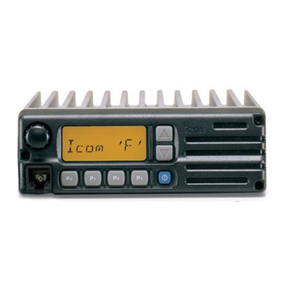
Icom
Icom IC-F1020 User manual
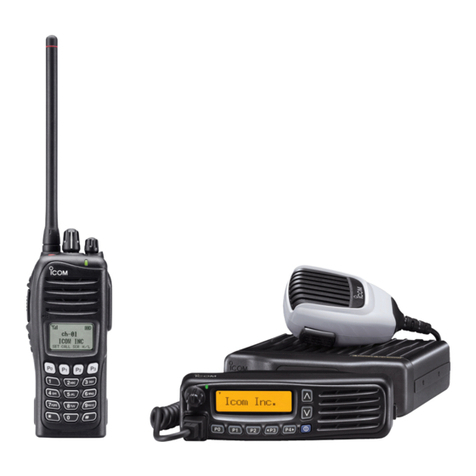
Icom
Icom F3161 Series Operating instructions

Icom
Icom MOBILE RADIO User manual

Icom
Icom IC-2720H Operating instructions

Icom
Icom IP100H User manual

Icom
Icom IC-SAT100M User manual
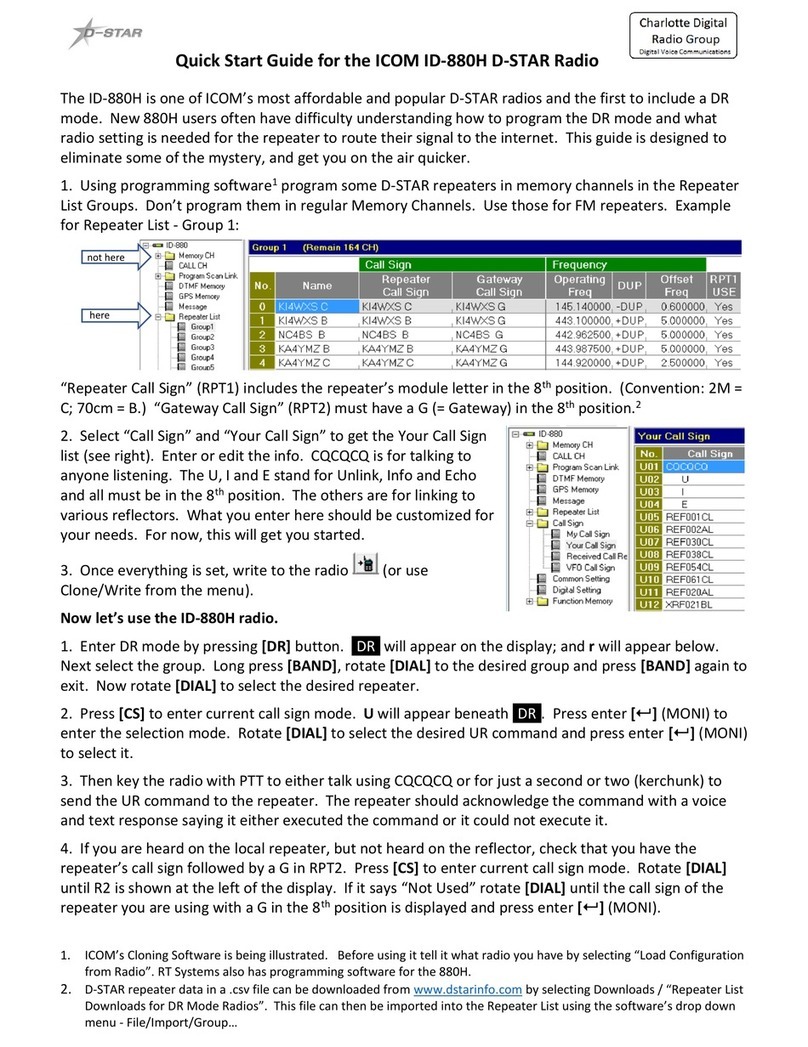
Icom
Icom ID-880H User manual
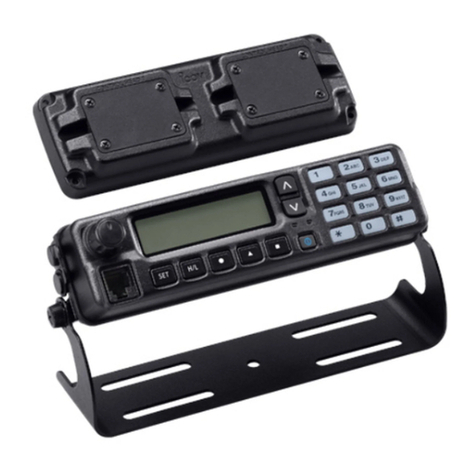
Icom
Icom RMK-4 User manual
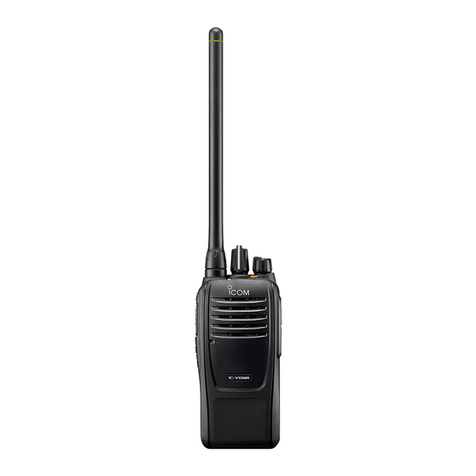
Icom
Icom V10MR Operating instructions
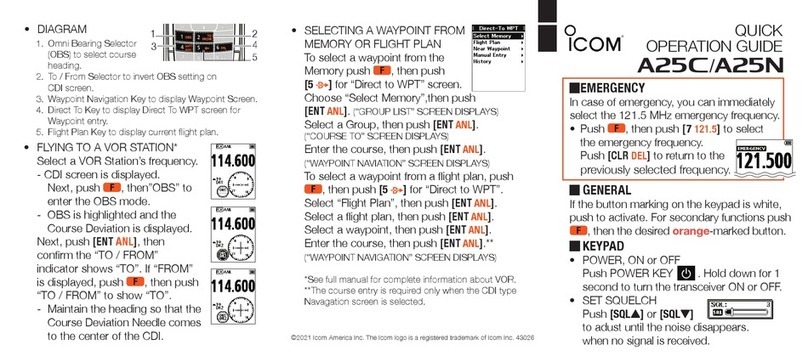
Icom
Icom A25C SPORT 66 USA User guide
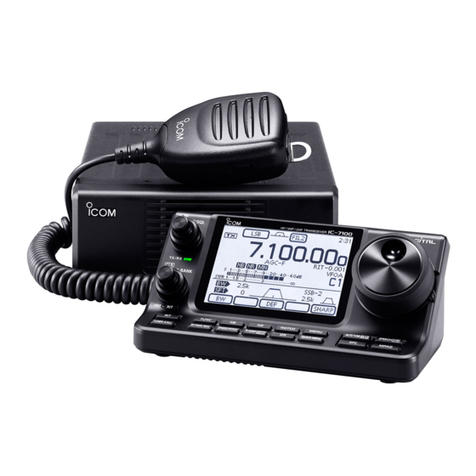
Icom
Icom IC-7100 User manual
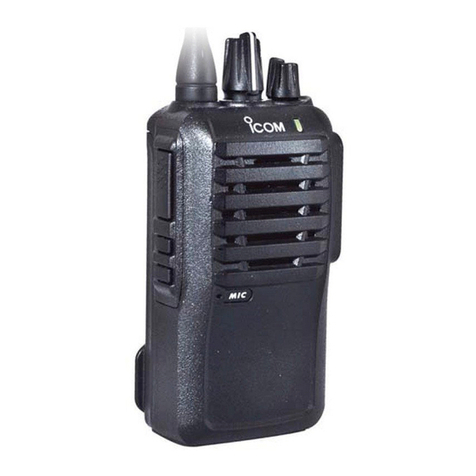
Icom
Icom IC-F3001 Installation and operating instructions
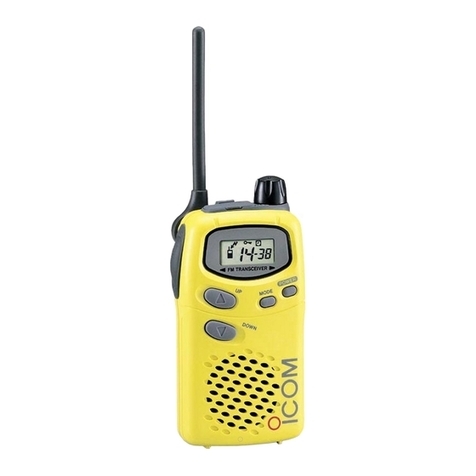
Icom
Icom IC-4008A User manual
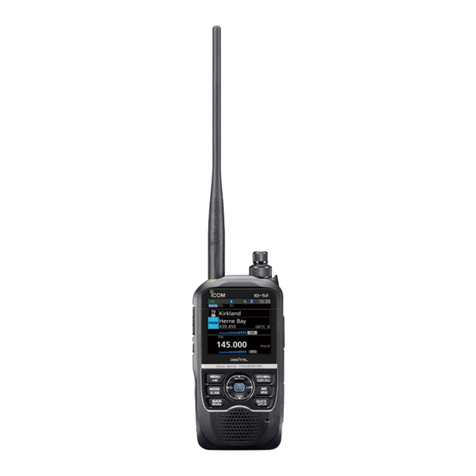
Icom
Icom ID-52A User manual

Icom
Icom IC-F1010 User manual
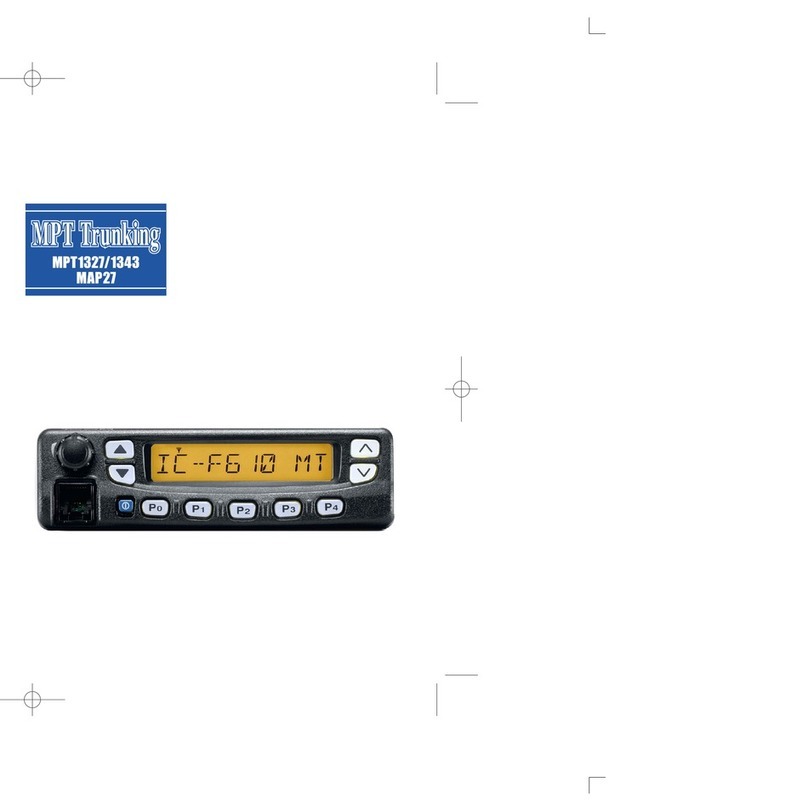
Icom
Icom iF610 User manual

Icom
Icom ID-800H User manual
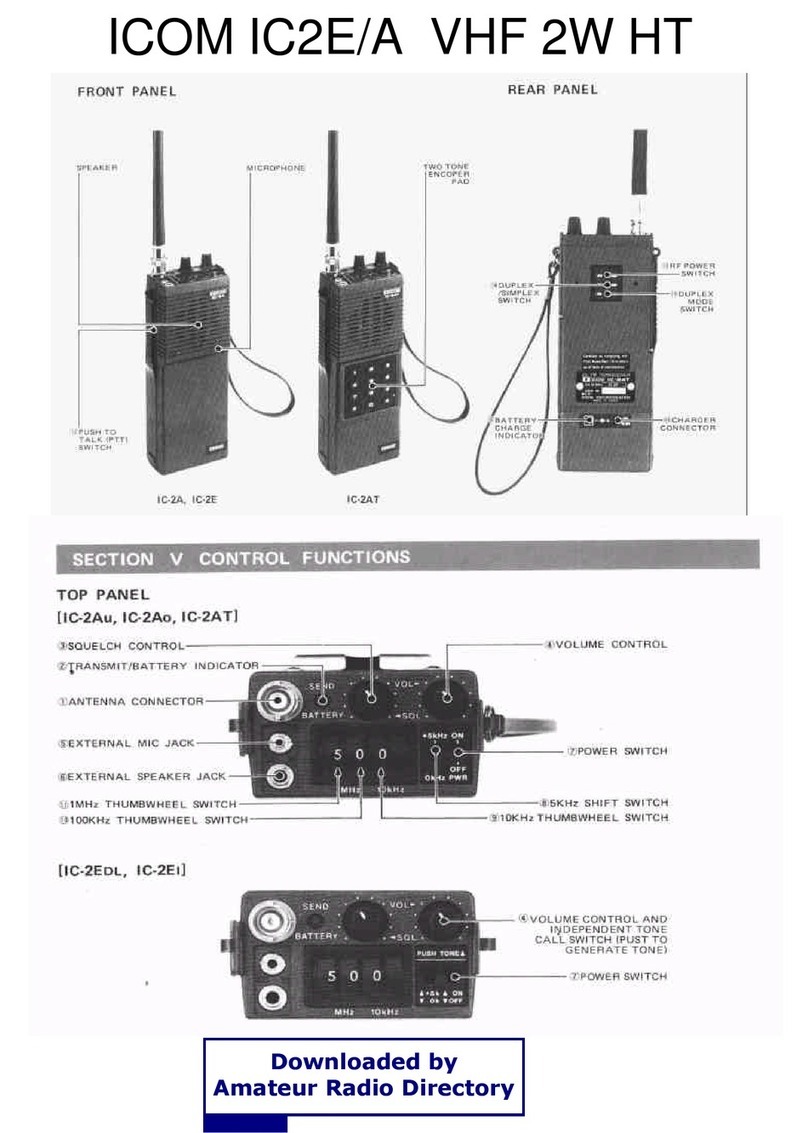
Icom
Icom IC2e/a User manual

Icom
Icom 9000 F70 Series Installation guide
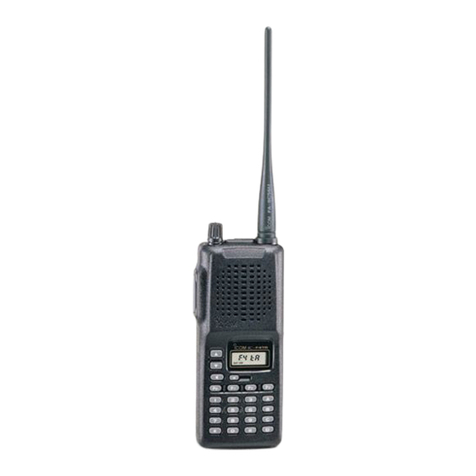
Icom
Icom IC-F4TR Guide
